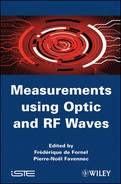Chapter 11
High Precision Pulsar Timing in Centimetric
Radioastronomy1
11.1. Introduction
Pulsars are very compact astrophysical objects detected via periodic signal and characterized by an exceptional stability — competing with the best man-made clocks. Those quasi-perfect clocks, spread throughout the Galaxy and sometimes embedded in excessively strong gravitational fields are used for many different studies. Two Nobel Prizes in Physics were already awarded for pulsar related works. In 1974, the first prize celebrated the discovery of pulsars. The second prize celebrated the discovery of binary pulsars and confirmation of general relativity in 1993. Continuing instrumental developments, always at the state of the art of the technology, are ever stimulated by the extraordinary capabilities provided by those astronomical objects. After a short description of the numerous scientific applications, we will describe the different methods used to time as precisely as possible, the regular radio pulses received from those objects. We will point out the coherent dedispersion method and we will demonstrate the astonishing possibilities of this method with several results obtained at the Nançay radiotelescope in France.
11.2. Ultra-stable clocks to the limits of the Galaxy
During studies of the interplanetary radio scintillation in 1967, highly magnetized neutron stars were discovered by serendipity (Hewish et al., 1968). Received as periodic pulses from unknown radio sources, they were named “pulsars”. Thought to have been created in the 1930s (Baade & Zwicky, 1934) from the remains of large supernovae, the neutron star was rapidly identified as the ideal candidate for such rapid rotations (~ 0.1−1 sec). The neutron star is characterized by a mass 1.4 times larger than our Sun, confined in diameter of the order of 10–20 km. Collimated electromagnetic waves can be emitted if the star has a high magnetic field (Pacini, 1967; Gold, 1968). Sweeping around the Earth at each star rotation, the pulsar is detected as a lighthouse on the seaside. The periodicity is a direct measurement of the star rotation rate. Currently, 1,794 pulsars are known, with periods for radio pulsars from 1.39 ms to 8 sec for the slowest (see the ATNF pulsar catalog, Manchester et al., 2005 and Lorimer & Kramer, 2004). It is important to note that the fatest pulsars are also the most stable, due to their very peculiar formation process. After the expulsion of the external layers of the exploding massive star, the core condensed to form a neutron star rotating at a period of around 30 ms and keeping a very high magnetic field. The pulsar quite rapidly slows down due to energy loss and the magnetic field decreases. After several millions years, the star rotates at a period of around 10 sec and the radio processes stops. The neutron star is now no longer visible as a pulsar. However, pulsars with a very short period and a very low magnetic field were detected (Backer et al., 1982). A recycling process was proposed, in which a companion star can be the source of mass and moment transfer. Then the radio emission starts again and the pulsar is seen with a rotation rate even faster than the birth rotation rate. An accretion disk is usually seen in X-rays during this acceleration phase. As the magnetic field remains low, breaking is negligible and the pulsar is then a very fast and highly stable clock for billions of years. In a traditional ![]() diagram (period derivative against period), the evolutionary path starts in the upper center, continues to the lower right where the radio emission turns off and where recycling can kick the pulsar off to the left during the accretion process (Figure 11.1). At the lower left of the
diagram (period derivative against period), the evolutionary path starts in the upper center, continues to the lower right where the radio emission turns off and where recycling can kick the pulsar off to the left during the accretion process (Figure 11.1). At the lower left of the ![]() diagram are the fast recycled pulsars which are the most stable and interesting to study. Nature is very kind to provide scientists with such high quality clocks spread over the Galaxy and also in binaries where they are excellent tools for testing the gravitation theories.
diagram are the fast recycled pulsars which are the most stable and interesting to study. Nature is very kind to provide scientists with such high quality clocks spread over the Galaxy and also in binaries where they are excellent tools for testing the gravitation theories.
Since the very first pulsar discoveries, increasingly better instrumentations have been created to derive the times of arrival of their radio pulses as precisely as possible. Among the very successful studies made possible by such high precision timing measurements, two are probably the most important. The first is related to fundamental physics. In binary systems consisting of two neutron stars (the second star usually not seen in radio), it is possible to detect several relativistic effects due to the very high gravitational field. As soon as enough so-called post-newtonian parameters are precisely measured, a test of the different theories describing the gravitation can be conducted. So far, the general relativity theory has succeed (Taylor & Weisberg 1982; Kramer et al. 2006). Taking general relativity as a proper description of such systems, we can use the precise parameters to strongly constrain the mass of the two stars. Figure 11.2 shows the mass constraints for the double pulsar
Figure 11.1. The famous ![]() diagram shown for all pulsars of any kind (radio, “radio-quiet”, soft-gamma repeaters, and anomalous X-ray pulsars). Lines of constant characteristic age τ, magnetic field B and spin-down luminosity Ė are shown. The grey regions denote area where radio pulsars are not expected by theoretical models to exist (source: Lorimer & Kramer, 2004)
diagram shown for all pulsars of any kind (radio, “radio-quiet”, soft-gamma repeaters, and anomalous X-ray pulsars). Lines of constant characteristic age τ, magnetic field B and spin-down luminosity Ė are shown. The grey regions denote area where radio pulsars are not expected by theoretical models to exist (source: Lorimer & Kramer, 2004)
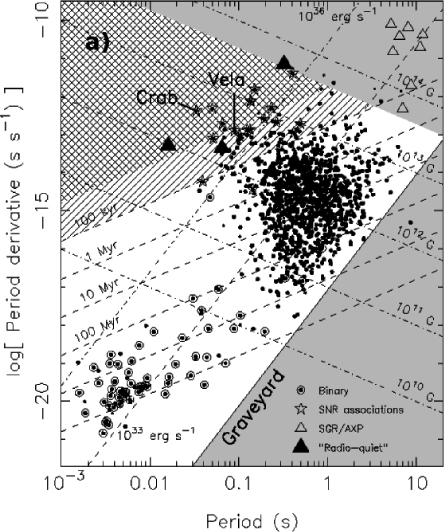
system PSR J0737-3039 obtained from Nançay timing measurements. The second study is long term, requiring an international collaboration to be successful. Through the perturbation induced in the radio time of arrivals of the set of well distributed pulsars, there is hope of detecting the imprint of cosmological gravitational wave backgrounds. Indeed, several cosmological theories predict emission of gravitational waves during the very first seconds after the Big Bang at the origin of our universe, and high precision timing of stable pulsars could probe this very early cosmological era (Foster & Backer 1990; Jaffe & Backer 2003).
Figure 11.2. “Mass-mass” diagram showing the observational constraints on the masses of the neutron stars in the double pulsar system J0737-3039 from Nançay observations. Measure of two or more post-Keplerians parameters can be used to check the validity of any gravitation theory
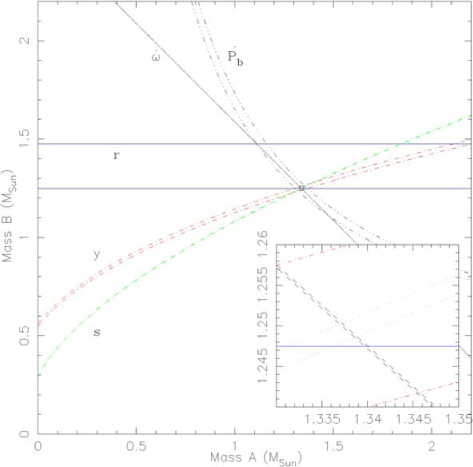
11.3. Dispersion by the interstellar medium
If the first pulsars were discovered directly on pen-chart recorders looking for regularly spaced pulses (Hewish et al., 1968), the next searches were based on recorded signal and computerized post-processing (Hulse & Taylor, 1974).
Periodicity searches in the Fourier domain successfully to found faint pulsars, which have their individual pulses buried in noise. Most recent analyses are still using Fourier transform but coupled with acceleration methods, in order to be able to discover pulsars in tight binary systems (Ransom et al., 2003). The large acceleration suffered by the pulsar during the time of observation makes the use of a cluster of powerful computers necessary to properly process the data.
In addition to the weakness of the signal and a potential acceleration, the main factor perturbing the observation is the dispersion by the interstellar medium. Any
Figure 11.3. Dispersion delay due to the ionized component of the interstellar medium observed on the Crab pulsar (Period = 33 ms). This pulsar is at the center of a remnant, remains of a supernova observed in 1054 by the Chinese. Here, the signal was integrated in phase with the rotation of the star in each 4-MHz frequency channel between 1,368 and 1,428 MHz
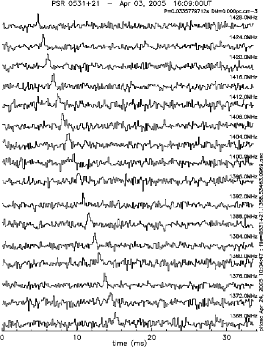
radio wave propagating in the interstellar medium suffers from the dispersion produced by the free electrons. Even with a very small electronic density of the order of 0.03 e−cm−3, the distance traveled by the radio wave is so large that the added dispersive delay inversely proportional to the squared frequency is comparable to the pulsar's period or greater (Figure 11.3).
Strictly speaking, modification of the propagating signal can be described as a filter acting only on the phase. The transfer function, for a signal centered at fo, can be written as:
![]()
where D is the dispersion constant (related to the plasma frequency fP of the medium characterized by an electronic density ne, D = fP/2cne) and D M is the dispersion measure, which is the electronic content integrated over the line of sight ![]() .
.
11.4. Instrumentation used to study pulsars
The dispersive effect is useful to determine the mean electronic content along the line of sight, if we know the distance; or to derive the distance, if we have a reliable idea of the electronic density (observations made at different radio frequencies, from 100 MHz to a few GHz typically are necessary). This effect also has to be taken into account to get good quality measurements. As pulsars are weak radio sources, we need large radiotelescopes (100 m diameter or more) corresponding to a collecting area of the order of 10, 000 m2, in order to detect and study them. For a given telescope, data quality can be improved by integration of the signal in time; frequency also plays a major role.
Integration in time is relatively easy. We just need to know, with enough precision, the future evolution of the apparent period of the pulsar, in order to fold the signal accordingly. A set of Tchebitchev polynomials built from previously known pulsar parameters is used during the real-time folding of the data. A tough calculation made by the code tempo (Hobbs et al. 2006; Edwards et al. 2006) is necessary to take into account the source motion (if the pulsar is in a binary system) and the receiver motion (the radiotelescope lying on Earth moving in space). For the fatest pulsars, characterized by a rotation period of few milliseconds, there are millions of rotations during a typical 1-hour observation. So, for example, we need to know the period and its variations with 10 significant digits if we want to limit the cumulative error below 10−4 (all the other parameters to be known also at different levels).
Integration in frequency is done over a bandwidth of the order of 100 MHz for most of the observations around 1.4GHz. Over such a large bandwidth, it is common to get a large differential dispersive delay, sometimes corresponding to several pulsar rotations. If nothing is done, the radio pulse is spread in time and can even become no longer periodic. Several methods were developed to dedisperse the radio signal for pulsar observations. Two main families are distinguished.
The incoherent dedispersion applies temporal delay after detection of the signal split over many narrow frequency channels. The signal phase was not recorded and is lost during the integration process (over several microseconds). This corresponds to filterbank based instrumentation and we should remember that residual dispersion is still present within each individual frequency channel.
The coherent dedispersion processes the data using all the phase information. Changing the phase of the signal using a transform filter inverse to the dedispersion eliminates any residual effect within each frequency channel, and this is a decisive advantage.
11.5. Swept local oscillator dedispersion
In the late 1980s at Nançay, we developed an enhanced version of the swept local oscillator (LO) dedispersion method (McCulloch et al., 1979). Several LOs can be found in the signal path of the telescope to convert to lower frequencies, which are much easier to handle. One of these LOs is replaced here by a swept oscillator, which has a frequency changing in time with the same behavior as the interstellar medium induced dispersion (Cognard et al., 1995). The result of this special mixing is directly sent to an autocorrelator (a 50 MHz bandwidth autocorrelator was used at Nançay) to produce a frequency image of the temporal pulse. Since the mixing is done before the detection of the signal in the autocorrelator, this is a coherent dedispersion. This method is limited by the difficulty to precisely control the swept frequency. In addition, the frequency is swept over a small bandwidth (tens of MHz), when we presently want hundreds of MHz. After ~ 20 years of use, this instrumentation is not maintained anymore at Nançay.
11.6. Filterbank dedispersion
Filterbank instrumentation is typically able to provide detected data within individual ~ 1 MHz frequency channels every few tens of microseconds. With appropriate temporal shifting and the addition of channels, it is easy to build a dedispersed pulse from any given pulsar over a large bandwidth. However, this technique suffers from systematic bias. Indeed, the interstellar medium is turbulent and acts as a random phase screen on the propagating wave. On Earth, those distortions produce a diffraction pattern where the pulsar strength has rapid spatial and temporal fluctuations (known as “scintillation”, see Figure 11.4). When coupled to the residual dispersion present within an individual channel, the intensity variations produce a random temporal shift of the pulse (Figure 11.5). The shifts directly translates into systematic errors in times of arrival. At Nançay, we had a filterbank instrumentation suffering this limitation from 1998 to 2003: the NBPP (Navy Berkeley Pulsar Processor) with 96 channels each 1.5MHz (Backer et al., 1997). This instrumentation was in fact mainly used to conduct a pulsar survey (Foster et al., 1997), which successfully discovered two young pulsars (Ray et al., 1999).
Figure 11.4. Scattering and scintillation produced by the interstellar medium inhomogenities
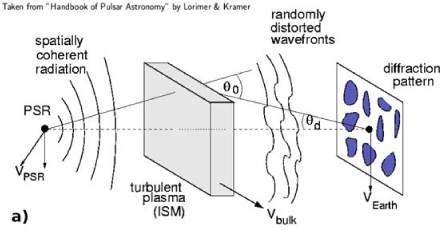
Figure 11.5. Random delays produced by the residual dispersion within a channel in the presence of scintillation
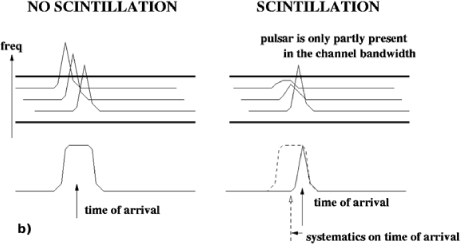
11.7. Real-time coherent dedispersion
When a time of arrival uncertainty of the order of 1 μs or less is the goal, the different incoherent filterbank instrumentations are replaced with coherent dedispersion instrumentations, roughly designed more than 30 years ago (Hankins & Rickett, 1975).
The instrumentation doing the coherent dedispersion with a computer acts directly on the radio signal phase. A complex signal is built through a “complex down-converter”, which does the last conversion to lower frequencies and provides the amplitude and phase of the signal. Indeed, the incoming signal is first mixed with a local oscillator to produce I when a second signal Q is built by mixing with the same local oscillator but with a phase shift of 90 degrees. The next step is to have a low-pass filter (a few hundred MHz) to get amplitude and phase of a band limited signal received on the antenna.
Sampling has to be done at a sufficient rate to keep all the information contained in the signal. To make the dedispersion process easier, synthesis of narrower channels (a few MHz) is done just after conversion by a polyphase filter bank (PFB) implemented in an FPGA device. The four time series (2 complex polarizations) corresponding to the different channels are sent to a cluster of computers to dedisperse the signal.
The inverse of the transfer function of the interstellar medium H will be applied on the complex Fourier transform of the signal in every channel. To have a better rejection between channels, H−1 is multiplied by an apodization function. Here, we should keep in mind that this dedispersion process corresponds to a convolution in the time domain. We have to process a data length at least equal to the dispersion delay between the upper and the lower edge of the channel bandpass (nDM data points corresponding to tDM = 8.3 × 106 ms × DM × Δf × f−3). Moreover, a discrete convolution of each point of a time series of length nDM depends on nDM/2 points both before and after it. It is then necessary to pad the voltage series with that amount of data at the beginning and at the end. Altogether, the Fourier transform on which the inverse function will be applied, needs to be at least 2*nDM long. In practice and to minimize the waste due to the overlap, a power of 2 lengths larger than 2 * nDM is chosen. With a 2 * nDM overlap, the “wings” of length nDM/ 2 at the beginning and at the end of the voltage series are ignored after convolution by function H−1. To come back in the time domain after the inverse Fourier transform, the data are folded coherently with the pulsar rotation rate. An adequate description of the rotational phase of the pulsar must be formed. Every minute or so, the folded dedispersed polarized profile is recorded. The real-time data processing in the Fourier domain over a large bandwidth, in the order of several hundred MHz, required a huge computing power, usually provided by a cluster of PC (running Linux).
Figure 11.6. Panoramic view of the coherent pulsar instrumentation at Nançay (SerendipV spectrometer, data servers and dedicated cluster)

11.8. The coherent pulsar instrumentation installed at Nançay
At Nançay, a coherent pulsar instrumentation was developed and installed in collaboration with colleagues from the University of California, Berkeley: BON (Berkeley-Orléans-Nançay) (Demorest, 2007). A “SerendipV” spectrometer designed and built at Berkeley is doing the 8 bits acquisition of two complex polarizations over a 128 MHz bandwidth. Within the FPGA of the spectrometer, the polyphase filter bank device provides 32 4-MHz channels sent for dedispersion into 4 parallel data links (1 Gbs = 128 MBs each). Until July 2008, the data went through 4 dataservers used to sort the frequency channels and was sent to a large 64 bi-proc AMD Athlon 1.2 GHz cluster. Due to the difficult maintenance task, the cluster was most of the time only able to process 64 MHz, half of the total available bandwidth. In early 2008, we started to study alternatives to this large and old cluster (it was installed late 2001). We did try the PlayStation 3 (Sony Corp.) but the only gigabit link is a decisive bottleneck. While the computing power is very interesting regarding the cost of each unit, no more than half of the capability is used because the input data rate
Figure 11.7. View of the GPUs (graphics processing units) based dedispersion instrumentation
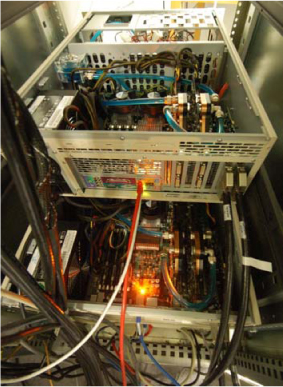
is severely limited. Following preliminary tests conducted by Demorest (personal communication), we built a computer hosting a graphics processing units (GPU) from Nvidia (GeForce 8800GTX) which successfully passed all the tests, being able to process ~ 40–50 MHz of bandwidth easily. Since July 2008, two computers each hosting two GPUs and receiving 2 data links (2 Gbs) are large enough to dedisperse the 128 MHz bandwidth (Figure 11.7). Folded profiles obtained within each channel are processed to produce times of arrival. The offset between the daily profile and a high quality version of the pulse (called “template”) is determined via a cross-correlation method (Taylor, 1992).
The enhancement provided by the coherent dedispersion can be as large as a factor 2. Figure 11.8 shows the result obtained on the millisecond pulsar J0613-0200, where the 4.7 to 1.4 μs improvement is only due to the instrumentation. The quality of the measures is here characterized by the mean uncertainty of the times of arrival (ToA) of the radio pulses. The times of arrival residuals are shown as the differences between the measured ToAs and the ToAs calculated with a propagation model and a set of pulsar parameters.
An example of the exceptional quality of the data is obtained on the millisecond pulsar J1909-3744 (Jacoby et al., 2003). This short period pulsar (P = 2.94 ms)
Figure 11.8. Enhancement observed on the millisecond pulsar J0613-0200 timing from a filterbank instrumentation (before 2000), from the Nançay radiotelescope upgrade (2000) to the coherent instrumentation (from 2004)
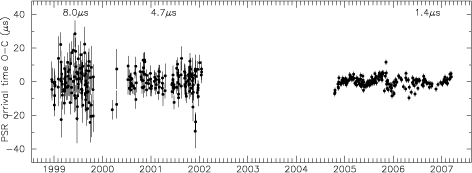
presents a very narrow pulse suitable for good timing measurement (Figure 11.9). Over a 4 year period, the pulsar ToAs residuals are characterized by a weighted rms just over 100 ns (Figure 11.10). This amazing result is made possible by the conjunction of a large and efficient radiotelescope and a state of the art coherent instrumentation. Pulsars like J1909-3744 are not very common but are very important to build a pulsar timing array to search for cosmological gravitational wave backgrounds.
Figure 11.9. High quality radio pulse profile for the millisecond pulsar J1909-3744 observed at Nançay. Integrated over 24 h of data, this profile is used as a template to determine the ToAs by a correlation method
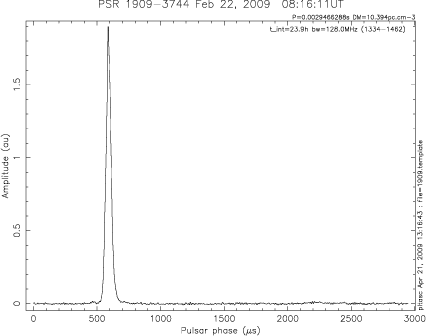
Figure 11.10. ToA residuals for the pulsar J1909–3744 observed at Nançay, characterized by a weighted rms of 109 ns
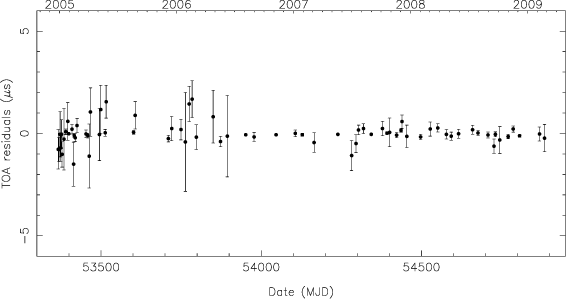
The Nançay radiotelescope is conducting two main pulsars timing programs. The first program is devoted to a multi-wavelength study of pulsars and provides a large number of highly precise rotational ephemeris to allow the detection of pulsars at higher energy with the Fermi telescope. The different emission models can be tested by comparison of the pulse shapes observed in radio and high energy. The second program participates to the elaboration of a pulsar timing array, a coordinated time of arrival database used to probe the gravitational waves left after the very early stage in the Big Bang theory of the origin of the universe. Both programs are conducted in the European pulsar timing array (Janssen et al., 2008), when a similar effort is in place in Australia with the Parkes pulsar timing array (Manchester, 2008) and in the US with Nanograv. A further step is currently taking place with world wide collaboration, the IPTA (international pulsar timing array).
11.9. Conclusion
The different pulsar instrumentations installed in the different radiotelescopes around the world can achieve a timing accuracy lower than 100 ns, as long as a coherent technique is used. Those instrumentations remove the interstellar dispersion directly in the phase of the incoming voltage signals. The very high quality data obtained on a number of very stable pulsars can be used for many different studies. Among them are the tests of the different theories of gravitation and the search for cosmological gravitational waves backgrounds. This last topic is currently pushing all the different radiotelescopes pulsar groups in the world toward a tight and hopefully successful collaboration.
11.10. Bibliography
Baade W., Zwicky F., “On Super-novae”, Proceedings of the National Academy of Science, vol. 20, p. 254–259, 1934.
Backer D. C., Kulkarni S. R., Heiles C., Davis M. M., Goss W. M., “A millisecond pulsar”, Nature, vol. 300, p. 615–618, December, 1982.
Backer D. C., Dexter M. R., Zepka A., Ng D., Werthimer D. J., Ray P. S., Foster R. S., “A Programmable 36-MHz digital filter bank for radio science”, PASP, vol. 109, p. 61–68, January, 1997.
Cognard I., Bourgois G., Lestrade J.-F., Biraud F., Aubry D., Darchy B., Drouhin J.-P., “High-precision timing observations of the millisecond pulsar PSR 1937+21 at Nançay”, A&A, vol. 296, p. 169–179, April, 1995.
Demorest P. B., Measuring the gravitational wave background using precision pulsar timing, PhD thesis, University of California, Berkeley, August, 2007.
Edwards R. T., Hobbs G. B., Manchester R. N., “TEMPO2, a new pulsar timing package-II. The timing model and precision estimates”, MNRAS, vol. 372, p. 1549–1574, November, 2006.
Foster R. S., Backer D. C., “Constructing a pulsar timing array”, ApJ, vol. 361, p. 300–308, September, 1990.
Foster R. S., Ray P. S., Cadwell B. J., Backer D. C., Lestrade J.-F., Cognard I., Martin J.-M., Maitia V., “A fast sampled high frequency pulsar survey of the galactic plane”, Bulletin of the American Astronomical Society, vol. 29, December, 1997.
Gold T., “Rotating neutron stars as the origin of the pulsating radio sources”, Nature, vol. 218, p. 731–732, May, 1968.
Hankins T. H., Rickett B. J., “Pulsar signal processing”, Methods in Computational Physics. Volume 14 — Radio Astronomy, vol. 14, p. 55–129, 1975.
Hewish A., Bell S. J., Pilkington J. D., Scott P. F., Collins R. A., “Observation of a rapidly pulsating radio source”, Nature, vol. 217, p. 709–713, February, 1968.
Hobbs G. B., Edwards R. T., Manchester R. N., “TEMPO2, a new pulsar-timing package-I. An overview”, MNRAS, vol. 369, p. 655–672, June, 2006.
Hulse R. A., Taylor J. H., “A high-sensitivity pulsar survey”, ApJ, vol. 191, p. L59–L61, July, 1974.
Jacoby B. A., Bailes M., van Kerkwijk M. H., Ord S., Hotan A., Kulkarni S. R., Anderson S. B., “PSR J1909-3744: a binary millisecond pulsar with a very small duty cycle”, ApJ, vol. 599, p. L99–L102, December, 2003.
Jaffe A. H., Backer D. C., “Gravitational waves probe the coalescence rate of massive black hole binaries”, ApJ, vol. 583, p. 616–631, February, 2003.
Janssen G. H., Stappers B. W., Kramer M., Purver M., Jessner A., Cognard I., “European pulsar timing array”, Bassa C., Wang Z., Cumming A., Kaspi V. M. (eds.), 40 Years of Pulsars: Millisecond Pulsars, Magnetars and More, vol. 983 of American Institute of Physics Conference Series, p. 633–635, February, 2008.
Kramer M., Stairs I. H., Manchester R. N., McLaughlin M. A., Lyne A. G., Ferdman R. D., Burgay M., Lorimer D. R., Possenti A., D'Amico N., Sarkissian J. M., Hobbs G. B., Reynolds J. E., Freire P. C. C., Camilo F., “Tests of general relativity from timing the double pulsar”, Science, vol. 314, p. 97–102, October, 2006.
Lorimer D. R., Kramer M., Handbook of Pulsar Astronomy. Volume 4, Cambridge University Press, UK, 2004.
Manchester R. N., Hobbs G. B., Teoh A., Hobbs M., “The Australia telescope national facility pulsar catalogue”, AJ, vol. 129, p. 1993–2006, April, 2005.
Manchester R. N., “The Parkes pulsar timing array project”, Bassa C., Wang Z., Cumming A., Kaspi V. M. (eds.), 40 Years of Pulsars: Millisecond Pulsars, Magnetars and More, vol. 983 of American Institute of Physics Conference Series, p. 584–592, February, 2008.
McCulloch P. M., Taylor J. H., Weisberg J. M., “Tests of a new dispersion-removing radiometer on binary pulsar PSR 1913+16”, ApJ, vol. 227, p. L133–L137, February, 1979.
Pacini F., “Energy emission from a neutron star”, Nature, vol. 216, p. 567–568, November, 1967.
Ransom S. M., Cordes J. M., Eikenberry S. S., “A new search technique for short orbital period binary pulsars”, ApJ, vol. 589, p. 911–920, June, 2003.
Ray P. S., Cadwell B. J., Lazio T. J. W., Foster R. S., Backer D. C., Cognard I., Lestrade J.-F., “J0248+60 and J2240+58: two new pulsars from a high-frequency survey of the galactic plane”, Bulletin of the American Astronomical Society, vol. 31, p. 903−+, May, 1999.
Taylor J. H., Weisberg J. M., “A new test of general relativity — gravitational radiation and the binary pulsar PSR 1913+16”, ApJ, vol. 253, p. 908–920, February, 1982.
1 Chapter written by Ismaël COGNARD.
